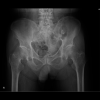Femoral Neck Fracture in a Hemodialysis Patient after Liver Transplantation: A Case Report
- PMID: 33490699
- PMCID: PMC7817843
- DOI: 10.2490/prm.20210003
Femoral Neck Fracture in a Hemodialysis Patient after Liver Transplantation: A Case Report
Abstract
Background: Surgical treatment of femoral neck fractures is usually performed as an urgent procedure so that restoration of the ability to stand and walk can be achieved as quickly as possible. However, orthopedic surgeons need to be aware of undertreated or untreated diseases in their patients. Organ transplant recipients require immunosuppressive agents and steroids postoperatively. Hemodialysis patients also exhibit immunological deterioration and are included among immunocompromised patients. We report a case in which conservative treatment was chosen for a hepatic transplant recipient on hemodialysis who suffered a femoral neck fracture because signs of inflammation of unknown etiology were intermittently seen.
Case: The patient was a 70-year-old man who had undergone liver transplantation from a living donor as treatment for hepatocellular cancer and hepatic failure with cirrhosis. Dialysis for end-stage renal failure was initiated at approximately 1 year postoperatively. Cyclosporine was administered as an immunosuppressive agent. The patient subsequently fell off a bicycle and was unable to walk because of right hip pain. He was brought to our hospital by ambulance, and a right hip radiograph revealed a femoral neck fracture. His white blood cell count and C-reactive protein levels were intermittently elevated with unknown etiology. Conservative treatment was finally adopted, although a bipolar hip arthroplasty was planned. At 5 months after the injury, the patient was able to walk alone in a stable manner using a pair of crutches and was discharged.
Discussion: Conservative treatment for a femoral neck fracture, which generally requires surgery, may be acceptable in organ transplant recipients on hemodialysis.
Keywords: conservative treatment; femoral neck fracture; hemodialysis; organ transplantation.
©2021 The Japanese Association of Rehabilitation Medicine.
Conflict of interest statement
CONFLICTS OF INTEREST: The authors certify that there are no conflicts of interest with any financial organizations regarding the material discussed in the manuscript.
Figures




Similar articles
-
[The role of core decompression for the treatment of femoral head avascular necrosis in renal transplant recipients].Acta Med Croatica. 2012 Oct;66 Suppl 2:76-80. Acta Med Croatica. 2012. PMID: 23513422 Croatian.
-
Fractures of the femoral neck: a review and personal statement.Acta Chir Orthop Traumatol Cech. 2006;73(1):45-59. Acta Chir Orthop Traumatol Cech. 2006. PMID: 16613748 Review.
-
Complications after tibial tubercle traction and femoral neck fractures in children: a case report.Postgrad Med. 2021 May;133(4):460-464. doi: 10.1080/00325481.2021.1874701. Epub 2021 Jan 29. Postgrad Med. 2021. PMID: 33441046
-
What Are the Risk Factors for Dislocation of Hip Bipolar Hemiarthroplasty Through the Anterolateral Approach? A Nested Case-control Study.Clin Orthop Relat Res. 2016 Dec;474(12):2622-2629. doi: 10.1007/s11999-016-5053-3. Epub 2016 Aug 30. Clin Orthop Relat Res. 2016. PMID: 27577065 Free PMC article.
-
Successful treatment for bilateral femoral neck insufficiency fractures: a rare lesion case report and an updated review of the literature.BMC Musculoskelet Disord. 2020 Feb 14;21(1):102. doi: 10.1186/s12891-020-3107-x. BMC Musculoskelet Disord. 2020. PMID: 32059654 Free PMC article. Review.
Cited by
-
The therapeutic effect of fixation using alternative implants for the treatment of hip fractures (FAITH) in elderly patients with femoral neck fractures after falls: a meta-analysis.Eur J Med Res. 2025 May 29;30(1):427. doi: 10.1186/s40001-025-02684-3. Eur J Med Res. 2025. PMID: 40442837 Free PMC article.
References
Publication types
LinkOut - more resources
Full Text Sources
Other Literature Sources
Research Materials

